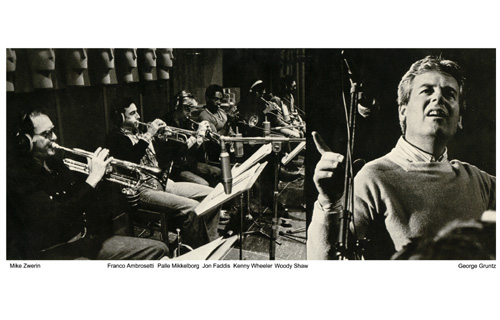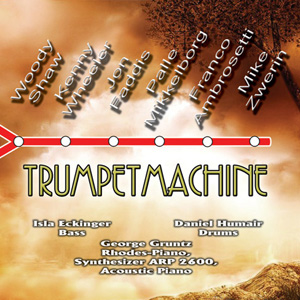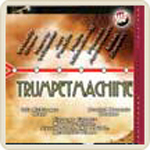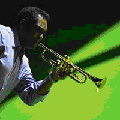| TRUMPET
MACHINE
una
rara rimasterizzazione
| |
 |
|
| |
Mike Zwerin,
Franco Ambrosetti,
Palle Mikkelborg,
Jon Fiddis,
Kenny Wheeler,
Woody Shaw,
Daniel Humair
Palle Mikkelborg
|
|
Daniel
Humair
Blending power, elegance, and thoughtfulness, Swiss drummer Daniel
Humair has worked with the best American and European jazz musicians.
He quickly became a staple among European drummers, first in a bop
style, then adopting the sophistication of West Coast drummers such
as Shelly Manne and later absorbing Elvin Jones' influence.
Despite an early but less than encouraging introduction to music,
Humair only got interested in this art form when he reached 14 and
heard a recording by Tommy Ladnier and Mezz Mezzrow. Working tremendously
hard to make up for the lost time, he rapidly became a professional
musician and started to perform in ballrooms. In 1958, he won several
awards at the Zurich Jazz Festival. This recognition led to his
first European tours with Don Byas, Guy Lafitte, Jacques Pelzer,
and Floris Nico Bunink. In November 1958, he moved from Belgium
to Paris at the invitation of Barney Wilen. There, he worked with
Lucky Thompson, Oscar Pettiford, Bud Powell, and vibist Michel Hausser,
with whom he made his first recordings. Subsequently, he joined
Martial Solal's trio and stayed with the pianist until 1965. This
significant collaboration helped him develop his sound and improve
his arranging skills. During that time, he also worked as a sideman
with a lot of American musicians passing through Paris and collaborated
with two of the most important French jazz musicians of the era:
pianist René Urtreger and bassist Pierre Michelot. In the
mid-'60s, he formed a unique trio with violinist Jean-Luc Ponty
and organist Eddy Louiss. In 1968, his career took a critical turn
with the beginning of his four-year tenure with Phil Woods &
His European Rhythm Machine. Following this experience, he played
in a trio with pianist Gordon Beck and bassist Ron Matthewson.
During the '70s, he most notably appeared with various editions
of the Michel Portal Unit. At the end of the '70s, he created another
trio with saxophonist François Jeanneau and bassist Henri
Texier. The combo helped give a new direction to the French jazz
scene by developing a local repertoire still rooted in the jazz
tradition but taking its distance from the American model. In 1985,
another important step in the drummer's evolution was his association
with Joachim Kühn and Jean-François Jenny-Clark. The
trio remained active until the untimely passing of Jenny-Clark and
helped him mature as a composer. In the '90s, he decided to focus
on his activities as a painter, which started to influence his drumming,
helping him to work on textures and better define the relationship
between the drums and the other instruments. This did not prevent
him from remaining present on the jazz scene. Under the moniker
Reunion, he invited various soloists to perform with him. Other
highlights include his participation in an all-star quartet with
Enrico Rava, Miroslav Vitous, and Franco d'Andrea, and the creation
of a trio with Bruno Chevillon and Marc Ducret. In 2001, he launched
Baby Boom, a project involving much younger musicians.
Jon Faddis
Born in 1953, Faddis began playing at age eight, inspired by an
appearance by Louis Armstrong on television. Meeting Dizzy Gillespie
at 15 proved to be a pivotal beginning of a unique friendship that
spanned over three decades. Shortly after his 18th birthday, Faddis
joined Lionel Hampton's band, moving from Oakland, CA to New York.
|
Faddis
worked as lead trumpet for the Thad Jones/Mel Lewis Orchestra
at the Village Vanguard, formed his own quartet, and soon
began directing orchestras, including the Grammy-winning United
Nation Orchestra, the Dizzy Gillespie 70th Birthday Big Band,
the Carnegie Hall Jazz Band (1992-2002), and the Jon Faddis
Jazz Orchestra of New York (2003-present). |
The
Chicago Jazz Ensemble, celebrating its 40th anniversary at Columbia
College Chicago in 2005-2006, named Faddis as its Artistic Director
in autumn 2004.
Faddis will continue to conduct both the JFJONY and the CJE in the
future. Faddis has also served as guest conductor and featured guest
with the Lincoln Center Jazz Orchestra.
Faddis' original compositions include the Jazz opera Lulu Noire
(1997) (named a "Top 10" pick by USA Today); others may
be heard on his Grammy-nominated Remembrances (Chesky), Into the
Faddisphere (Epic), and Hornucopia (Epic). Faddis' forthcoming CD,
TERANGA (KOCH Records, June 2006), features new compositions by
the trumpeter, joined by members of the Jon Faddis Quartet - David
Hazeltine (piano), Kiyoshi Kitagawa (bass), & Dion Parson (drums)
- together with special guests Alioune Faye (sabor), Abdou Mboup
(djembe & talking drum), Russell Malone (guitar), Gary Smulyan
(baritone saxophone), Frank Wess (alto flute) and Clark Terry (flugelhorn
& vocals).
Faddis remains true to the tradition of honoring mentors, regularly
leading master classes and clinics worldwide, and also teaching
as a full-time faculty member at the Conservatory of Music, Purchase
College-SUNY (where he is Artist-in-Residence, Professor & Director
of Jazz Performance) and as guest lecturer at Columbia College Chicago.
Palle Mikkelborg
(b. 1941) started playing trumpet in 1956 and became a professional
musician in 1960. He consider himself an autodidact on trumpet.
At first he was a member of the Danish Radio Jazz Group and the
Danish Radio Big Band. As a leader of these bands in the 1970s,
he developed his skill as a composer and arranger.
Throughout the 1980's Mikkelborg toured Europe and Japan and made
recordings with Gil Evans Big Band, George Russel Big Band, Terje
Rypdal, Jan Garbarek, Gary Peacock, Dinu Saluzzi and others. He
was also a member of the successful Danish trio Heart to Heart with
Kenneth Knudsen and Niels-Henning Ørsted Pedersen.
The past ten years, he has led his own group with himself and his
wife, the Welsh harpist Helen Davies.
George Russell once said that he liked "the Scandinavian sound"
of Palle Mikkelborg. Russel would often ask him to open a concert
alone to create a musical landscape that only Palle could do. Russel
would then add the rhythm and the whole orchestra would slowly come
in. Mikkelborgs sensitivity and calm made it possible for him to
send an "echo or a sound out into the world" and wait
until it came back. This sensitivity, Russel had not found in musicians
from the US.
Palle Mikkelborg was awarded with The Nordic Council's Music Prize
for 2001. He received the prize 2nd of April 2001 in Oslo.
George
Gruntz's
George Gruntz's Concert Jazz Band, an orchestra that sticks to originals
by band members (both past and present) and the leader's arrangements,
has long been one of the most stimulating of all jazz big bands.
Gruntz, a fine pianist, played locally in Switzerland and then debuted
in the United States when he appeared with Marshall Brown's International
Youth Band at the 1958 Newport Jazz Festival. His trio in Europe
accompanied touring American musicians in the 1960s including Dexter
Gordon and Rahsaan Roland Kirk, and formed three-quarters of Phil
Woods' adventurous European Rhythm Machine (1968-1969). Gruntz recorded
in many different settings, including with the Swiss All-Stars,
a four-flute septet, and with Mideast musicians and Jean-Luc Ponty
on 1967's Noon in Tunisia. In 1972, he formed the Concert Jazz Band,
which through the years has featured a who's who of top musicians
including Benny Bailey, Woody Shaw, Franco Ambrosetti, Dexter Gordon,
Herb Geller, Phil Woods, Eddie Daniels, Ray Anderson, Lew Soloff,
Chris Hunter, Bob Mintzer, and many other Americans and Europeans;
they typically toured twice a year and even performed in China.
Gruntz has also recorded with smaller groups, and in the '90s and
2000s, his records have been released by Enja and TCB.
Kenny
Wheller
Although resident in England since 1952 and often thought to be
an English musician, Kenny Wheeler was born in Canada in 1930. He
began playing in his hometown of St. Catherines, encouraged by his
father, a trombonist. His formal studies include composition with
Rodney Bennett and William Russo. His earliest influences included
Buck Clayton and Roy Eldrige but, by the time he left for London,
he was looking towards bebop, Miles Davis and Fats Navarro particularly.
After his arrival in London, Wheeler balanced commercial dance band
work with gigs alongside modernists like Joe Harriott and Ronnie
Scott, and in 1959 joined the Johnny Dankworth band in time for
their breakthrough Newport Jazz Festival appearance. He consequently
came to be one of the major solo voices in the Dankworth orchestra,
and during the end of his stay recorded his first album as a leader
Windmill Tilter (Fontana), which featured compositions for big band
based on Cervantes’ Don Quixote stories. In 1966, a chance
encounter with drummer John Stevens at the Little Theatre Club in
London set Wheeler on a new course. To the surprise of many musicians
of his generation, the trumpeter became deeply involved in free
music and joined both Stevens’ Spontaneous Music Ensemble
and the Tony Oxley group. Through saxophonist Evan Parker and guitarist
Derek Bailey, Kenny was initiated into the Globe Unity Orchestra,
the German-based big band led by the pianist Alexander von Schlippenback.
His membership continues - he is prominently featured on the three
albums the Globe Unity Orchestra has recorded for JAPO/ECM.
In 1971, Anthony Braxton, impressed by Wheeler’s abilities
to play the demanding charts on the session for The Complete Braxton
(Freedom), invited him to join his group. Braxton’s music
became Wheeler’s priority until 1976, when the difficulties
of commuting between London and New York became overwhelming, but
in between he found time to record Song For Someone (Incus), a record
that juxtaposed free and jazz elements (and which became Melody
Maker Album Of The Year in 1975), and Gnu High (ECM 1069) a still
very fresh album with Keith Jarrett, Dave Holland and Jack DeJohnette.
Critics agreed that the ECM album marked a new high both for Wheeler
and for the label: Quintessential (Stereo Review), Unbeatable (Melody
Maker), Superb (Jazz Forum), Miraculous (Time Out) and so on. The
same critics, however, have tended to be less vocal in their support
for the trio Azimuth (Wheeler, John Taylor and Norma Winstone) whose
ECM albums are distinguished by their subtlety and require repeated
close listening for full appreciation.
Wheeler’s second ECM date was the 1977 recording Deer Wan
(ECM 1102), which featured Jan Garbarek, John Abercrombie, Dave
Holland, Jack DeJohnette and Ralph Towner. The album was viewed,
at the time of its release, as the most complete statement of Wheeler’s
musical intentions, and said one writer:
“Garbarek may very well be the trumpeter’s ideal front-line
partner...a kind of asceticism informs their playing; when they
are heard in tandem its impact is redoubled”.
The recording Double, Double You (ECM 1262) dates from 1983 sessions
and features Michael Brecker, John Taylor, Dave Holland and Jack
DeJohnette. Critics were enthusiastic for their release as this
excerpt from Fanfare indicates: “Wheeler is one of the more
fascinating trumpeters around. For this latest album, he utilizes
the prolific tenor saxophone of Mike Brecker to add even greater
strength to the front-line. John Taylor, Dave Holland and Jack DeJohnette
provide a powerful rhythm section which is sensitive and tasteful
while also offering incredible individual power...Highly recommended”.
In 1988, tours with his quintet whose members included John Abercrombie,
John Taylor, Dave Holland and Peter Erskine were received with enthusiasm
from press and public alike. Similar accolades can be expected for
their 1990 tour. Kenny is an active music educator as shown by his
presence on the faculty at the Canadian Banff Workshop and by his
involvement in international seminars. He also took part in the
Beethoven Fest 2002 in Bonn together with John Taylor. With John
Taylor he recorded two albums in 2001: the first one for EGEA, Moon,
with the participation of the clarinet-player Gabriele Mirabassi;
the second one for the French label Sketch together with the Italo-French
double-bass player Riccardo Del Fra.
In spite of his severe self-criticism and his almost legendary aversion
to recognition, Kenny Wheeler remains one of Europe’s most
sought-after trumpet and flugelhorn players.
Mike
Zwerin
Now best known as a columnist and contributor to Jazz Journal, Mike
Zwerin missed out on history during his days as a trombonist. He
played with the Miles Davis birth of the cool group during their
residency at the Royal Roost in the late '40s, but missed the recording
sessions and doesn't appear on the date. He studied violin and attended
the High School of Music and Art. Zwerin spent several years in
Paris before returning to America in 1958. He played with Claude
Thornhill, Maynard Ferguson and Bill Russo in the early '60s, then
played with Orchestra USA, serving as musical director and arranger
for a sextet culled from the orchestra's ranks. He worked in various
combos and toured the Soviet Union with Earl Hines in 1966. Zwerin
contributed jazz articles to The Village Voice, Rolling Stone and
Downbeat in the '60s, but quit playing at the end of the decade.
He returned to France and wrote novels and non-fiction. Zwerin moved
to Paris in the late '70s, and did some occasional playing while
contributing to such publications as the International Herald Tribune
and Jazz Journal. He's recently done some articles for Spin. Zwerin's
autobiography Too Close For Jazz, in 1983 has some provocative things
to say. ~ Ron Wynn, All Music Guide.
Woody
Shawn
Born on Christmas Eve, 1944, in Laurinburg, N.C., Woody Herman Shaw
began began playing bugle at age 9 in the Washington Carver Drum
and Bugle Corps, switching to trumpet at age 11. Surrounded by a
musical family (his father was a member of the Diamond Jubilee Singers),
and attracted to trumpet players such as Louis Armstrong, Harry
James, and Dizzy Gillespie, Shaw developed quickly into a strong
player by the end of grade school. After junior high, Shaw attended
the Arts High School in Newark, whose alumni included such prominent
jazz artists as Wayne Shorter, Sarah Vaughan, and Scott La Faro.
Around this time he began to meet prominent jazz heavyweights like
Kenny Dorham and Hank Mobley, took up piano, and began to immerse
himself fully in the New York jazz scene. At age 18, he went on
the road with Rufus Jones, soon after joining Willie Bobo at a time
when Bobo's band included Chick Corea.While appearing in New York
with a band that included Chick Corea and Joe Farrell, Shaw met
Eric Dolphy. In 1963 Shaw appeared on Dolphy's Eric Dolphy Memorial.
A year later, Shaw was asked by Dolphy to meet him in Paris to join
his group, but before Shaw could get there, Dolphy had passed away.
Shaw used the plane ticket to go to Paris anyway, where he stayed
for more than seven months, playing with such jazz luminaries as
Bud Powell, Kenny Clarke, Johnny Griffin, and Art Taylor.Upon returning
to the United States, Shaw spent time in the groups of Horace Silver
(1965-1966), Max Roach (1968-1969), and Art Blakey (1973), in addition
to making many recordings (some as a sideman for Blue Note) with
such players as Jackie McLean, Andrew Hill, Larry Young, and McCoy
Tyner.In 1973 his first album as a leader, The Moontrane, was released
on the Muse label, and was followed by several other excellent albums.
Shaw resisted the trend in the 1970s away from acoustic jazz music,
eschewing jazz-rock "fusion" in favor of further refining
the acoustic traditions begun in the bop era. In 1976 Shaw's group
(with Louis Hayes) backed Dexter Gordon in his return to New York
that resulted in the Grammy-winning recording Homecoming. Shaw soon
signed a recording contract with CBS/Columbia. By 1978, Shaw was
rated the top jazz trumpet player in the prestigious Downbeat Magazine
poll and his record, "Rosewood," was the No. 1 jazz album
in the same poll.
When Wynton Marsalis arrived on the scene in New York, Columbia
made the decision to release Shaw and use Marsalis as their torch-bearer.
Shaw continue to release albums under a variety of labels, including
Red, Enja, Elektra, Muse, and Timeless, but never regained the stature
for which he seemed destined in the mid 1970s.In the late 1980s,
Shaw had moved to Bern, Switzerland, and to Amsterdam, teaching
at several jazz schools and touring with various jazz bands in Europe,
including the Paris Reunion Band.On February 27, 1989, Shaw tumbled
down a stairway onto the tracks at Brooklyn's Dekalb Avenue subway
station where a train struck him, severing his arm. He remained
in the hospital until May 10, 1989, when he succumbed to kidney
failure.E
veral albums of live material have been released posthumously on
the High Note label. Most of the sessions which originally appeared
on Muse are now released by the 32 Jazz label.
Franco
Ambrosetti
Franco Ambrosetti (autore e compositore), figlio di Flavio Ambrosetti,
è nato il 10 Dicembre 1941 a Lugano (Svizzera).
Ha studiato il piano dal 1952 fino al 1959, allora impara da solo
dal 1959 a suonare la Tromba e inoltre suona anche il Flugelhorn.
Ha fatto il suo debutto professionale in 1961, quando all'età
di 20 ha fatto la sua prima apparizzione pubblica. Nella prima metà
degl’anni 60 crea un gruppo a Zurigo. Nel 1968 consegue la
laurea in economia a Basilea.
Ha registrato nel ’64 con George Gruntz e anche con Gato Barbieri
sotto la direzione del bassista Giorgio Azzolini.
Nel 1966 vince il primo premio all’ International Jazz Competition
di Vienna sotto la direzione del Sig. Fiedrich Gulda.
Il debutto Americano avviene con il quintetto del padre nel ’67
(Flavio Ambrosetti, capo musicista alto-sax dal ’50 al ’60)
suonando al Monterey Jazz Festival.
Fonda il suo gruppo con Gruntz, Daniel Humair, Ron Mathewson tra
il ’60 e il ’70.
Dal 1963 al 1970 suona con il quintetto del padre (con Gruntz e
Humair). Il gruppo continua oggi la relativa attività principalmente
come quartetto con Franco come capo-band. Nel 1972 forma The Band
con il padre, George Gruntz (pianista e compositore), Daniel Humair
( bassista), questa band verrà conosciuta poi come George
Gruntz Concert Jazz Band.
Freelance in Europa dagl’anni 70 Ambrosetti suona in molti
paesi differenti con Phil woods, Dexter Gordon, Cannonball Adderley,
Joe Henderson, Michael Braker-Mike Stern, Hal Galper, Kenny Clarke,
etc. Inoltre ha registrato come capo-band con Michael Brecker, Keeny
Kirkland, John Scofield, Ron Carter, Bennie Wallace, Phil Woods,
Dave Holland, Kenny Barron, Victor Lewis, Seamus Blacke. Ha anche
diretto un quartetto con musicisti pop Italiani come Alfredo Golino,
Antonio Farao e Dado Moroni. Come capo-gruppo ha registrato molti
album con svariati musicisti come Michael Brecker, John Scofield,
don Sebesky, Ron Carte, Phil Woods, Eddie Daniels, Dave Holland,
Kenny Barron, etc.
Durante la sua carriera, Franco Ambrosetti è apparso come
solista nei festival, concerti, spettacoli o date di registrazione
con vari gruppi come Kenny Clarke quintet, Phil Woods and the European
Rhythm Machine, Dexter Gordon quartet, Cannonball Adderley Sextet,
Joe Henderson group, The George Gruntz Concert Jazz Band, Michael
Brecker and Mike Stern group, Alfredo Golino quintet, Rene Urtregueir
quintet, ArnieLawrence’s Tresour Island group, Hal Galper
quintet, George Gruntz Duo, trio and quartet, Daniel Humair quintet,
Romano Mussolini quintet (a inizio carriera), Gato Barbieri quintet
and others.
Negli ultimi anni, Ambrosetti ha continuato a suonare con la George
Gruntz Concert Jazz Band e dirige il quintetto dal ’80, suona
regolarmente nei club di New York, come il Blue Note, Sweet Basil,
Bradleys, Visiones.
| |
 |
|
Un
breve accenno ... del CD ... "buon ascolto"
|
|
01.
For Flying our Proud! - Franco Ambrosetti - 5'45'' |
|
|
02.
Spring Song - George Gruntz - 6 '04'' |
|
|
03.
Anticipation - Franco Ambrosetti - 3'42'' |
|
|
04.
Hot Diggety Damn - Franco Ambrosetti - 4'53'' |
|
|
05.
Baal: Von Sonne Krank - George Gruntz - 3'07'' |
|
|
06.
Outfox no Kinxiwinx - Flavio Ambrosetti - 3'56'' |
|
|
07.
Faddis-Burger's Plunger-Fahrt - George Gruntz - 6'07" |
|
|
08.
A Wheler's Wings - George Gruntz - 3'26'' |
Etichetta
GOLDEN MAP

Catalogo N° G
CD J 1939
Anno 2007 |
Produzione esecutiva
di Massimo Monti
Musicisti Associati Produzioni M.A.P.
Distribuzione
M.A.P. |
questo
prodotto è acquistabile
al prezzo di €uro
12,99
più spese di spedizione
(clicca qui) |
|
o
in alternativa direttamente sul
nostro sito MAP SHOP,
con
pagamento con
Carta di Credito
(clicca
qui) |
| |
|
|
|
|
| |




